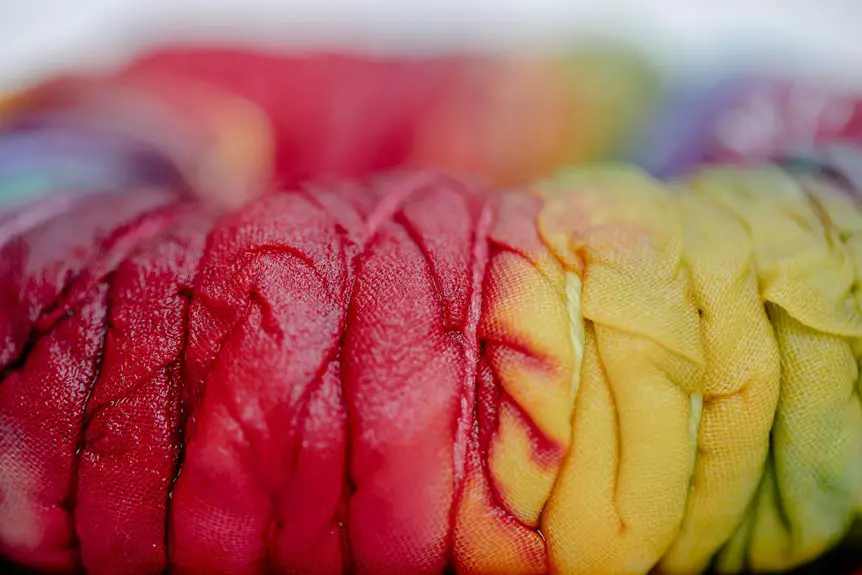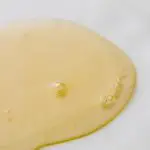When you run SDS-PAGE, Coomassie Blue dye plays a key role by binding to proteins and making them visible as vivid blue bands. The dye attaches through ionic and hydrophobic interactions, revealing protein size and abundance after separation by size. It’s easy, cost-effective, and sensitive, helping you quickly assess purity and molecular weight. While it has some limits, its reliability keeps it popular. Keep exploring to uncover detailed insights and tips for using Coomassie Blue effectively.
Table of Contents
Key Takeaways
- Coomassie Blue dye binds proteins in SDS-PAGE gels via ionic and hydrophobic interactions, producing visible blue bands for protein detection.
- It stains proteins after gel fixation, enhancing visualization of protein separation based on molecular weight.
- The dye’s strong affinity and stability under acidic conditions ensure sensitive and reproducible protein staining.
- Coomassie Blue allows quantitative analysis by correlating band intensity with protein concentration.
- It facilitates purity assessment and molecular weight estimation by highlighting distinct protein bands in electrophoresis.
Principles of SDS-PAGE and Protein Separation
Although it might seem complex at first, SDS-PAGE works by separating proteins based on their size. You start by treating your protein mixture with SDS, a detergent that unfolds proteins and coats them with a negative charge. This guarantees they all move toward the positive electrode during electrophoresis.
Once loaded into a polyacrylamide gel, the proteins travel through tiny pores; smaller proteins navigate these pores faster than larger ones. As you apply an electric current, proteins separate into distinct bands, each representing a specific size.
This method lets you analyze protein purity, estimate molecular weights, and compare mixtures effectively. By understanding these principles, you can better interpret your SDS-PAGE results and prepare for subsequent staining with Coomassie Blue dye.
Chemical Properties of Coomassie Blue Dye
After separating proteins by size through SDS-PAGE, you’ll want a reliable way to visualize them, and that’s where Coomassie Blue dye comes in.
This dye, specifically Coomassie Brilliant Blue R-250, is a triphenylmethane dye known for its intense blue color. It’s water-soluble and has a molecular weight around 854 g/mol.
The dye contains sulfonic acid groups, which impart negative charges, making it highly soluble in acidic solutions. You’ll notice its aromatic rings contribute to strong light absorption in the visible spectrum, which is why stained proteins appear vividly blue.
Coomassie Blue is stable under acidic conditions, allowing it to bind proteins effectively during staining. Understanding these chemical properties helps you appreciate why this dye is so effective and widely used in protein visualization after SDS-PAGE.
Mechanism of Protein Staining With Coomassie Blue
When you stain proteins with Coomassie Blue, the dye binds mainly through ionic and hydrophobic interactions.
You’ll notice the color develops as the dye-protein complex forms, producing a distinct blue band.
Understanding these binding dynamics helps you control staining sensitivity and specificity.
Binding Interaction Dynamics
Because Coomassie Blue dye binds directly to proteins in SDS-PAGE gels, you can visualize protein bands clearly after staining. The binding interaction happens mainly through non-covalent forces, which guarantee the dye selectively attaches to proteins.
Here’s what you need to know about this dynamic process:
- Electrostatic Interaction: The negatively charged sulfonic acid groups of Coomassie Blue attract positively charged amino groups on proteins, forming strong ionic bonds.
- Hydrophobic Interaction: The dye’s aromatic rings interact with hydrophobic regions of proteins, stabilizing the binding.
- Van der Waals Forces: These weak forces fine-tune the attachment, guaranteeing a stable yet reversible interaction.
Understanding these interactions helps you appreciate why Coomassie Blue is effective for protein visualization in SDS-PAGE without permanently altering the proteins.
Color Development Process
The way Coomassie Blue binds to proteins sets the stage for the color development you see in SDS-PAGE gels. When the dye interacts with protein molecules, it forms strong non-covalent bonds, primarily through ionic interactions and Van der Waals forces.
This binding changes the dye’s structure, shifting its absorbance spectrum and producing a vivid blue color. As you rinse the gel, unbound dye washes away, leaving only the protein-bound dye visible.
This selective retention guarantees proteins stand out sharply against a clear background. The intensity of the blue color directly correlates with protein quantity, allowing you to estimate protein concentration.
Protocols for Using Coomassie Blue in SDS-PAGE
Although Coomassie Blue staining might seem straightforward, following precise protocols guarantees clear and consistent protein visualization in SDS-PAGE.
To get the best results, you should:
- Fix the gel: Immerse it in a fixing solution (typically methanol and acetic acid) for about 30 minutes to immobilize proteins and remove SDS.
- Stain the gel: Submerge the fixed gel in Coomassie Blue dye for 1 hour or until bands appear distinct.
- Destain thoroughly: Use a destaining solution to wash away excess dye, enhancing band contrast without over-destaining.
Advantages of Coomassie Blue Compared to Other Stains
When choosing a stain for your SDS-PAGE, Coomassie Blue stands out for its strong sensitivity and low detection limits.
You’ll appreciate how easy it’s to use without complex preparation steps.
Plus, it’s cost-effective, making it a practical choice for routine protein analysis.
Sensitivity and Detection Limits
Since you’re aiming to detect proteins with clarity and accuracy, Coomassie Blue offers a reliable balance between sensitivity and ease of use.
While it doesn’t match the ultra-low detection limits of silver staining or fluorescent dyes, it still provides sufficient sensitivity for most protein analysis needs.
Here’s why Coomassie Blue stands out in sensitivity and detection limits:
- It detects protein quantities as low as 50-100 ng, which is adequate for routine SDS-PAGE analysis.
- It produces a linear response over a broad concentration range, helping you quantify protein amounts effectively.
- Its consistent staining reduces variability, so your detection results are reproducible across experiments.
This combination lets you identify proteins confidently without sacrificing practicality or reliability.
Ease of Use
Because Coomassie Blue requires minimal preparation and straightforward protocols, you can stain your gels quickly without specialized equipment or complex steps.
Unlike some fluorescent or silver stains, it doesn’t need advanced imaging systems or lengthy processing times. You simply immerse your gel in the dye solution, rinse, and you’re ready to analyze. This simplicity makes it ideal when you need reliable results fast.
Plus, Coomassie Blue’s stable staining means you don’t have to rush to document your gel immediately. The dye binds consistently to proteins, providing sharp bands that are easy to see with the naked eye or a basic gel documentation system.
This user-friendly approach not only saves time but also reduces the chance of errors during staining and destaining.
Cost-Effectiveness
Beyond its ease of use, Coomassie Blue stands out for its cost-effectiveness, especially compared to other staining methods. When you use Coomassie Blue, you save money without sacrificing quality.
Here’s why it’s a smart choice:
- Affordable Reagents: The dye and associated chemicals are inexpensive and widely available, lowering your overall lab expenses.
- Minimal Equipment: You don’t need specialized tools or expensive imaging systems, which means fewer upfront costs and maintenance fees.
- Reusable Solutions: You can reuse staining and destaining solutions multiple times, stretching your budget even further.
Limitations and Challenges in Coomassie Blue Staining
Although Coomassie Blue staining is widely used for protein visualization in SDS-PAGE, you’ll encounter several limitations that can affect your results.
Sensitivity is one major challenge—it may not detect proteins present in very low amounts, potentially missing critical data.
Additionally, the staining process can be time-consuming, requiring careful handling to avoid uneven staining or background noise.
You might also face difficulties in distinguishing proteins with similar molecular weights due to limited resolution.
Moreover, Coomassie Blue binds nonspecifically to some contaminants, which can interfere with accurate interpretation.
Finally, once stained, the gel is generally not suitable for downstream applications like mass spectrometry without additional processing.
Being aware of these challenges helps you optimize your protocol and interpret data more reliably.
Applications of Coomassie Blue in Protein Analysis
Coomassie Blue plays an essential role in protein analysis by providing a reliable and straightforward method to visualize proteins separated by SDS-PAGE. When you use this dye, you quickly identify protein bands with high sensitivity and reproducibility.
Coomassie Blue offers a reliable, straightforward way to visualize proteins with high sensitivity and reproducibility.
Its applications include:
- Quantitative Analysis: You can estimate protein concentration by comparing band intensity against standards.
- Purity Assessment: Coomassie Blue helps you determine if your protein sample is pure or contains contaminants.
- Molecular Weight Estimation: By comparing protein migration to known markers, you can infer molecular weights.
These applications make Coomassie Blue indispensable for routine protein studies in research and diagnostics.
If you want quick, accurate, and cost-effective protein visualization, Coomassie Blue staining is an excellent choice.
Frequently Asked Questions
Can Coomassie Blue Stain Non-Protein Molecules in Gel Electrophoresis?
You can’t rely on Coomassie Blue to stain non-protein molecules effectively during gel electrophoresis. It specifically binds to proteins, so other molecules won’t show up clearly when you use this dye for staining.
How Does Temperature Affect Coomassie Blue Staining Intensity?
Coincidentally, as temperature rises, you’ll notice Coomassie Blue staining intensifies because increased heat enhances dye-protein binding. However, if it gets too hot, staining can weaken due to dye diffusion or protein denaturation.
Is Coomassie Blue Safe for Use in Educational Settings?
You can safely use Coomassie Blue in educational settings if you handle it carefully. It’s mildly toxic, so wear gloves and avoid ingestion or inhalation. Always follow proper lab safety protocols to stay protected.
Can Coomassie Blue Staining Be Reversed After Visualization?
Like trying to erase a permanent marker, you can’t fully reverse Coomassie Blue staining after visualization. However, you can destain gels to reduce background, but the protein bands will still retain some color.
What Are the Storage Conditions for Coomassie Blue Dye Solutions?
You should store Coomassie Blue dye solutions in a cool, dark place, ideally at 4°C. Keep containers tightly sealed to prevent contamination and evaporation, ensuring the dye remains stable and effective for future use.
- What Is Cotton Percale Bedding? A Complete Overview - July 14, 2025
- How to Use a Percolator: A Beginner’s Step-by-Step Guide - July 14, 2025
- What Is Percale Cotton? A Refresher on the Basics - July 14, 2025






